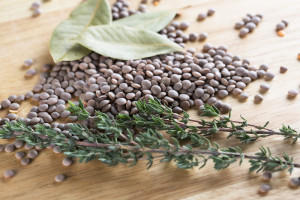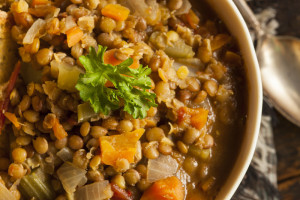Winter is just around the corner (if you are living Down Under) and I can’t wait to tuck into some of those beautiful slow cooked comfort foods that are synonymous with cold weather. A time for some of those tasty body warming casseroles, spicy middle eastern dishes cooked in my trusty tagine and steaming, health giving, hearty soups.

And one of my favourite economical protein additions to any of these dishes is some of the many different legumes and pulses. As lentils are one of my favourites and are among the most versatile and nutritious foods available I have decided today to tell you a bit more about them as they are well worth having in your kitchen pantry.
What Are Lentils?
Lentils are an edible type of legume or pulse. They are composed of a number of quality nutrients and can be used as a healthy, cheap food staple for everybody – not just vegetarians. Lentils can be many different colors – red, green, brown, or even golden or black. They resemble split peas; however, they do not taste as sweet.
Their taste does not change according to colour. However, green lentils possess greater amounts of fibre than the others, which makes them slightly healthier.
Lentils are believed to have originated in the Middle East (central Asia) and to have been among the first crops to have been cultivated there. Apparently they have been consumed since prehistoric times so nothing new here.
Nutritional Facts And Health Benefits Of Lentils:
A Good Source of Fibre
Since lentils contain significant amounts of dietary fiber, they help to keep your bowels nice and healthy which is very important. This is because the fiber helps to regulate bowel movements and can prevent or put an end to constipation.
Furthermore, lentils contain large amounts of soluble fiber, which can reduce cholesterol levels. This keeps your arteries clean reducing your risk of incurring heart disease or getting a stroke. So in other words, a great heart food.
Has a Low Glycemic Index
Due to their low glycemic index, lentils are processed quite slowly by your body. Consequently, they make you feel fuller for longer than other foods do. This, in turn, stabilizes blood sugar levels so if you have diabetes, lentils are one food you should learn to love and should become a staple in a diabetic diet.
Since lentils cause you to feel fuller for longer time, they also cause you to eat less so this in turn helps to lose weight. How good is that?
If you are keen to learn more about the GI of different foods then this info from The University of Sydney GI News will go a long way towards helping you balance your dietary needs. Also, one of the internet’s most comprehensive lists of foods with their glycemic index is available at The GI Diet Guide. These are two great resources if you are looking to lose weight and are wondering which are the best foods to be eating.
A Great Source Of Protein
Lentils are high in protein content – in fact, they are composed of approximately 26% protein.
Therefore, they make for an excellent meat substitute. In fact, they are a healthier source of protein than either meat or fish, because they contain considerably lower amounts of saturated fat than meat or fish do, and they contain zero cholesterol. So you can see, lentils constitute a very healthy protein choice for you and your family.
A Source of B Vitamins
Lentils contain high amounts of B-group vitamins, such as iron, calcium, magnesium, phosphorus and zinc. It is extremely important to consume the right amount of B-vitamins, because they play an essential role in human health and well-being.
The human body uses B-vitamins to produce energy and to make the nervous system function correctly. It also uses B-vitamins to reinforce memory and strengthen concentration skills, to grow and develop hair, nails and skin and to contribute to a healthy pregnancy by preventing structural and functional anomalies in babies.
Furthermore, B-vitamins prevent anemia and cardiovascular illnesses. They are also used in the process of DNA synthesis, prevent cancer, promote mental health, help to regulate premenstrual syndrome, stabilize morning sickness and prevent stones from forming in the kidneys.
Low In Saturated Fat, High In Folate
As if all these benefits weren’t enough, lentils contain very little saturated fat, and high amounts of folate. Folate contributes to tissue growth and cell functioning. Therefore, it is important that women of child-bearing age incorporate it into their diets, as it helps to forestall certain birth defects from occurring in children.
Moreover, folate prevents people from developing gray hair (bit late for me), ulcers, poor growth and glossitis (swelling of the tongue). Folate also lowers your risk of heart disease by reducing your homocysteine levels (homocysteine contributes significantly to heart disease). Moreover, folate averts people from becoming depressed.
Need some more info about how good lentils are for you and your family then check out these 7 Health Benefits of Lentils.
Lentil Recipe Ideas
Lentils are extremely versatile and can be used in soups, stews, casseroles, salads and side dishes. They can also be made into fritters, burger patties, filling for sandwiches or stuffed into whole grain pitas.
They are also great to add to slow cookers with chicken or turkey legs, diced beef, lamb shanks and vegetable dishes. You can even use them to make a great hummus – just replace the chick peas with lentils and add a few Moroccan spices for that authentic taste.

Moroccan lentil soup is a favourite at our house and is easy to make as well as being a very satisfying and easy meal. After cooking your lentils (in stock for extra flavour), add some diced vegetables of your own choice, fresh chopped herbs from your garden and then season with a little soy sauce, cumin, turmeric and cayenne (taste as you go). Like some more protein in your soup – then dice a skinless chicken breast and throw in as well.
To make this dish really quickly use 2 cups of salt reduced chicken or vegetable stock, a tin of lentils (drained and well rinsed), a tin if diced tomatoes (this is optional) and then add all the other ingredients above and simmer until cooked and there’s your dinner. What could be easier than that? Makes a great Sunday lunch on a cold day too.
Also, since lentils are such a good source of protein they are ideal for vegetarians as a main dish and also a great low fat substitute for anyone wanting to have a meat-free day which is a good thing to do once a week.
The Mayo Clinic on their Nutrition and Healthy Eating page also has a few really good tips on how to prepare lentils. It is worth a quick look.
Everything In Moderation
As with everything we eat it is important not to eat too much of any one specific food. Despite being an extremely healthy food source lentils can also cause some repercussions if eaten in excessive quantities. These include the formation of gall stones and flatulence (but I am sure your friends will soon let you know if you are eating too many lentils).
Cheers John – your Active Ageing Mentor and Coach.
P.S. I would love you to share your favourite lentil recipes with us.
Thanks for sharing this. I love the recipe and I love the knowledge about lentils that you shared.
Thanks Jhoei…….I appreciate your comments. Cheers – John.